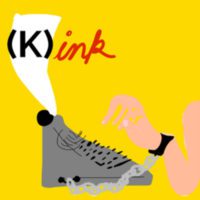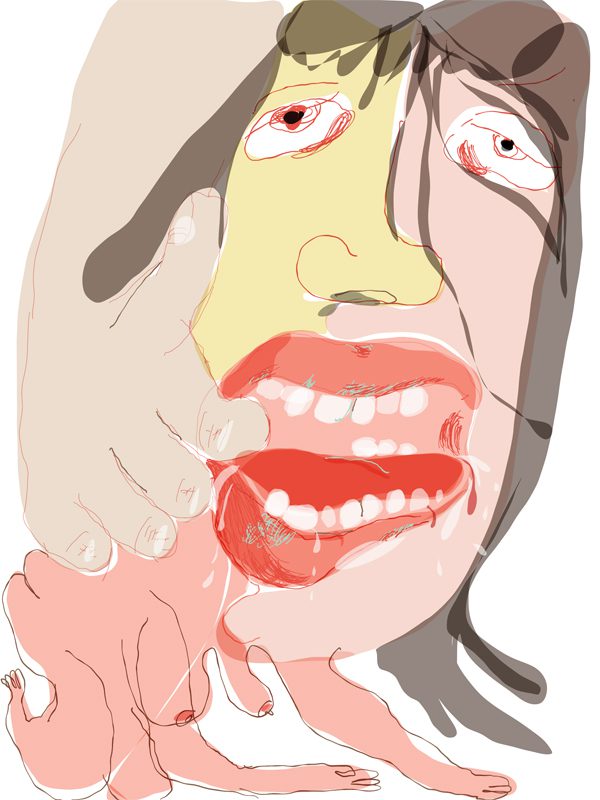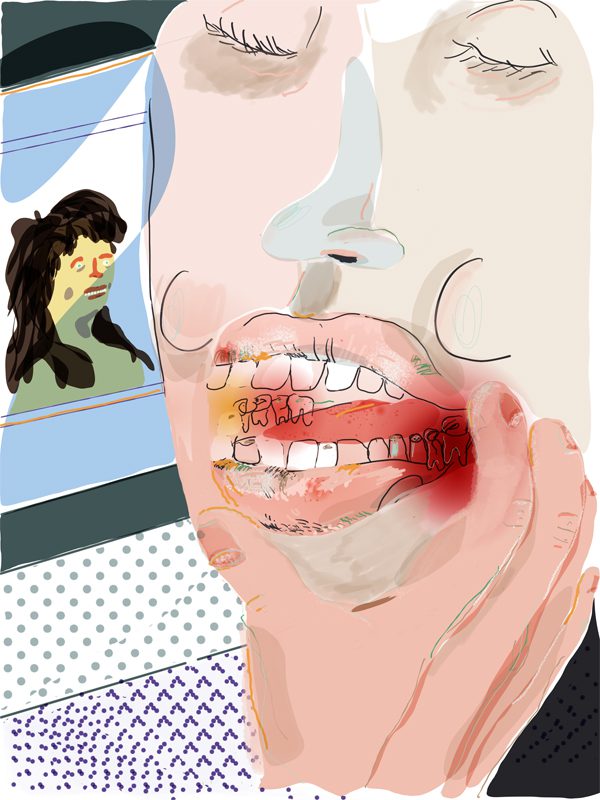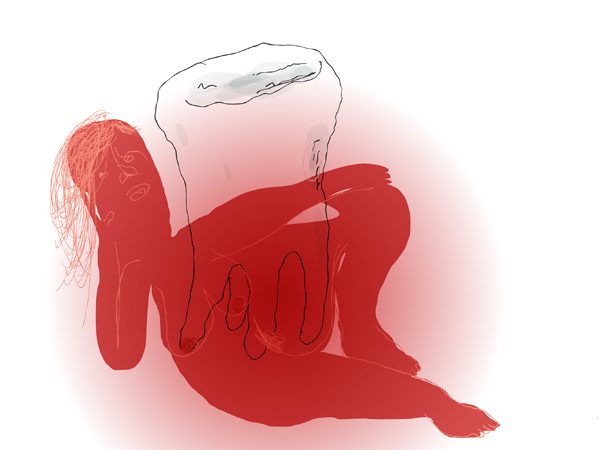There’s evidence that D.H. Lawrence enjoyed an erotic power exchange relationship with his wife, that James Joyce was into scat (among other things), and that Oscar Wilde—well, most of us know what Oscar Wilde liked. These literary geniuses explored radical sexual agency and desire in their work and in their relationships, but little beyond rumors and personal letters exist to tell us what they themselves thought of their turn-ons and the ways in which those dovetailed with their writing. Even if space for such a discourse and community had existed back then, Lawrence, Joyce and Wilde couldn’t freely discuss their sexuality. As it was, they faced censorship and generated scandal wherever they went, and of course Wilde went to prison for his sexual behavior.
Although our world is still intolerant of sexual difference, I want to believe we’re at a point where people can speak openly about the consensual ways we express our erotic selves. And I’m interested in the connections between those private expressions and the larger, more public work we do in the world. This series is meant as a forging of community; a validation of that which gets called sexual deviance; and a proud celebration of the complex, fascinating ways that humans experience desire.
In this ongoing series of short personal essays, writers in all genres—novelists, poets, journalists, and more—explore the intersection between our literary lives and practices and our BDSM and fetishistic lives and practices. In other words, these essays aren’t about writing about non-normative sex: rather, it’s a series about how looking at the world through the lens of an alternative sexual orientation influences the modes and strategies with which one approaches one’s creative work.
If you have questions or comments, or if you’re a writer who would like to contribute, please contact me at kinkwriting@gmail.com.
–Arielle Greenberg, Series Editor
***
Open Wide: Dental Kink and Somatic Writing
I ask her to hook her fingers into my mouth and pull. Catch me, your little fish upriver. Pull me out from still water. Make me show up to your bed. I am right here; make me feel it.
And she does.
Somatic writing is a language of the body. The practice is denser than a documentation of the physical: it is a dialogue between breath and text. Does this word fit into the hollows of your collarbone? Or is it more honest at your feet? In his essay “Somatic Poetics” in a 2011 issue of Jacket 2, Thom Donovan describes this process:
Somatics, like experimental art and poetry, is about finding the right words from the ground up, in relation to embodied conditions… The body, and language as a body, becomes the beginning of the world again. A ritual of decreation and recreation, of (world) unmaking and remaking.
And how does one begin a dialogue with the body? By giving what it needs. Pleasure.
Blue-gloved fingers spread lips out from teeth. I am told to keep my mouth open, wider please, to accommodate the orthodontist’s work. A metal pointed tool, something like a hooked scalpel, pulls off the pink rubber bands from brackets. They are rough little things, essentially a metal box glued onto each tooth.
As more bands come off, the current wire pops out, only to be replaced by a slightly thicker model. I ask him to jump a wire. Go thicker than it should be. He asks if I can handle it. I nod. Usually the difference in girth is as gradual as possible in order to limit pain. But I don’t mind. I want to feel this for weeks.
Part of the appeal of dental kink is the throbbing high of secrecy. It’s a turn-on to be indecent in public spaces. After play with my partner, or after visits with the orthodontist, the aftershock follows me around for days. I bring my hand to chin, lightly rapping knuckles against tender gums. Time compounds. I might be taking the metro through the city, but I am also everywhere I have ever been. Pain does that. Memories split off from the bone, little shards catching in my eyes.
Dental play is always at least slightly incorporated into my sex life with my partner. How could it not be? So much of us is told to one another through the mouth. Her skin takes my teeth and mine welcomes hers.
Afterwards, I like to watch the markings disappear. Sometimes there is impromptu role play, and other times what we do with pain is without classification.
Teeth eager at her inner thigh. Nipping along the femoral artery. Words pour out.
On another visit, the orthodontic surgeon strongly suggests that two teeth be pulled. Otherwise, I will eat my own head, the lower row of teeth eventually tearing a hole into the roof of my mouth. He promises I can keep the removed teeth. This is breaking a rule—other dentists have said as much—so I immediately trust him and consent to the procedure.
Needle at the gum. Three shots of anesthetic. A wrench is used to uproot the incisors. Ripping crack. It only takes a moment. He stuffs wads of cotton into my mouth and wipes my face clean of blood.
Medical touch can be absurdly intimate, and/or violent, depending on your experiences. Personally, I crave non-sexual aftercare. I want to be put right. Part of me somehow still believes in the fantasy that I can just hand myself over to someone else and be fixed. It is my little reenactment. First, for my dislocation to be seen. And second, for someone to intervene.
There are many people who cannot afford any kind of assistance, let alone dental care. I used to be in this category, and now must prioritize the different kinds of care I am able to access. Somatic writing has helped me in navigating these complexities.
My recovery is quicker than most. I rinse the depression with saline solution morning and night, a ceremonial cleansing of sorts. Each day these front six teeth are pulled back by stubborn molars. Oxen plow. I embrace the discomfort, sinking the pain from my mouth down to my cunt. Shot of thunder between the legs. Watch for rain.
Now the gap fills. What does the body remember? Somatic writing pulls out buried images, photographs with blurred faces. Road signs from long ago car trips you pretended to know how to read. Thick fingers. A melting yellow popsicle.
Somatic writing is not a linear affair, oftentimes relying on implicit memory. The practice borrows much in the way of theory from somatic healing modalities. You will not know where you are going, or where you once were, until you arrive. In an interview on writing her novel Ban en Banlieue, Bhanu Kapil details this connection:
How can writing be the place where an interoceptive nervous system is tracked? The sensorimotor sequence is a sequence of glitches, subtle movements, trembling, voltage—that, in somatic trauma therapies, is: tracked. So that a sequence can be completed. To release: a response to trauma that has been lodged—as a loop or distortion/contraction—in the body. To shake until the shaking stops.
What brings back the breath? This is my central question. My shaking is a red child body, nothing but blood pushing up against skin. Kink unlocks my jaw, releasing stale language. An opening to crawl out from dissociation.
Bone remodeling is the process by which old bone is broken down by the body in order to create new bone. Dentistry counts on this to move teeth around in the mouth. It is a ritual of remaking, not unlike writing. In Lee Gutkin’s book of essays Hurricanes and Carnivals, Gloria Anzaldúa says this of her writing practice:
I get deep down into the place where it’s rooted in my skin and pluck away at it, playing it like a musical instrument—the fingers pressing, making the pain worse before it can get better. Then out it comes. No more discomfort, no more ambivalence. Until another needle pierces the skin. That’s what writing is for me, an endless cycle of making it worse, making it better, but always making meaning out of the experience, whatever it may be.
Flossing can be either delicately or absurdly painful. Sometimes blood leaks out, gums inflamed from the pressure forced onto them by the whole process. Worse before it can get better. I go back for more.
I cannot remember the first time, or every time, I have bled from parted lips. Yet this sensation is stored deep. Flossing, as both dental hygiene and/or erotic play, stirs it up. Blood seeping from my gums. I want to be clean (sometimes). Pulling minted string through the gaps between small bones. I will have to do this again. Tomorrow and the day after that.
I cannot always write and I cannot always be touched in the usual places. My mouth, though. My mouth is where I keep myself. Knowing when and where to establish boundaries is a direct result of my combined writing and sexual practices. Playing towards and over the edge until you need it to stop. Limits become known.
Behind my lips, these doors, is an ever-steady growl of hunger. I ask her to stuff herself inside my mouth. It is part suffocation, part entrapment, and part speed this up, push my teeth into alignment.
If there is going to be pain, let it be by choice.
Braces carry a lot of shame baggage, especially so for adult wearers. There’s also a lot of shame surrounding deviant sexual practices. Dental kink isn’t anything I’d read about, or encountered, until my very own mouth was strung up in metal. Even still, the recesses of the internet don’t quite cover my particular niche. Some people are attracted by braces, and especially so when the wearer looks like or dresses up as a little or a baby. That’s not me; I don’t want to play that role. If anything, my braces make me a monster. Weaponized. Ready to devour and be devoured.
I’ve been here before. Role play, bondage, impact play, vibrator torture, etcetera. I switch between roles of submission and domination, never fully agreeing with or settling into the separations of desire.
What I want is not simple. For me, kink is all wrapped up in concerns of, and sometimes disregard for, safety. How I navigate pleasure/pain has a lot to do with both my queerness and survivorhood. Again, switching back and forth, living in the edges. Not easily categorized, nor able to stay put. I think this translates into my writing: a body on the run.
What I want: to be dangerous while in danger.
***
Rumpus original logo and art by Liam Golden.







